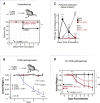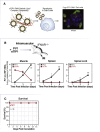A defective viral genome strategy elicits broad protective immunity against respiratory viruses
- PMID: 34852237
- PMCID: PMC8598942
- DOI: 10.1016/j.cell.2021.11.023
A defective viral genome strategy elicits broad protective immunity against respiratory viruses
Abstract
RNA viruses generate defective viral genomes (DVGs) that can interfere with replication of the parental wild-type virus. To examine their therapeutic potential, we created a DVG by deleting the capsid-coding region of poliovirus. Strikingly, intraperitoneal or intranasal administration of this genome, which we termed eTIP1, elicits an antiviral response, inhibits replication, and protects mice from several RNA viruses, including enteroviruses, influenza, and SARS-CoV-2. While eTIP1 replication following intranasal administration is limited to the nasal cavity, its antiviral action extends non-cell-autonomously to the lungs. eTIP1 broad-spectrum antiviral effects are mediated by both local and distal type I interferon responses. Importantly, while a single eTIP1 dose protects animals from SARS-CoV-2 infection, it also stimulates production of SARS-CoV-2 neutralizing antibodies that afford long-lasting protection from SARS-CoV-2 reinfection. Thus, eTIP1 is a safe and effective broad-spectrum antiviral generating short- and long-term protection against SARS-CoV-2 and other respiratory infections in animal models.
Keywords: RNA viruses; SARS-CoV-2; antiviral; broad-spectrum; defective viral genomes; innate immunity; interferon; respiratory infection.
Copyright © 2021 Elsevier Inc. All rights reserved.
Conflict of interest statement
Declaration of interests Y.X., R.N., and R. Andino have submitted a patent application. Provisional patent application: recombinant enteroviruses and uses thereof. eTIP1. US Provisional Patent Filed 7/2020. The application was accorded serial no. 63/047,398. D.T. and R.N. are shareholders and employees of Aleph Therapeutics, Inc. E.B. is a shareholder and employee of Pine Biotech Inc.
Figures













Comment in
-
Defective viral genomes can protect against SARS-CoV-2 variants and other respiratory viruses.Nat Rev Immunol. 2022 Jan;22(1):5. doi: 10.1038/s41577-021-00668-y. Nat Rev Immunol. 2022. PMID: 34862485 Free PMC article. No abstract available.
-
Harnessing defective viruses to fight infections.Med. 2022 Jan 14;3(1):1-2. doi: 10.1016/j.medj.2021.12.006. Med. 2022. PMID: 35590140
Similar articles
-
Identification of a therapeutic interfering particle-A single-dose SARS-CoV-2 antiviral intervention with a high barrier to resistance.Cell. 2021 Dec 9;184(25):6022-6036.e18. doi: 10.1016/j.cell.2021.11.004. Epub 2021 Nov 10. Cell. 2021. PMID: 34838159 Free PMC article.
-
STING Agonist Induced Innate Immune Responses Drive Anti-Respiratory Virus Activity In Vitro with Limited Antiviral Efficacy In Vivo.ACS Infect Dis. 2024 Sep 13;10(9):3392-3407. doi: 10.1021/acsinfecdis.4c00504. Epub 2024 Aug 29. ACS Infect Dis. 2024. PMID: 39207884 Free PMC article.
-
Antiviral Activity of Influenza A Virus Defective Interfering Particles against SARS-CoV-2 Replication In Vitro through Stimulation of Innate Immunity.Cells. 2021 Jul 11;10(7):1756. doi: 10.3390/cells10071756. Cells. 2021. PMID: 34359926 Free PMC article.
-
Discovery and development of INNA-051, a TLR2/6 agonist for the prevention of complications resulting from viral respiratory infections.Antiviral Res. 2025 Feb;234:106063. doi: 10.1016/j.antiviral.2024.106063. Epub 2024 Dec 27. Antiviral Res. 2025. PMID: 39733845 Review.
-
Potential Broad-Spectrum Antiviral Agents: A Key Arsenal Against Newly Emerging and Reemerging Respiratory RNA Viruses.Int J Mol Sci. 2025 Feb 10;26(4):1481. doi: 10.3390/ijms26041481. Int J Mol Sci. 2025. PMID: 40003946 Free PMC article. Review.
Cited by
-
Virus-like Particles: Measures and Biological Functions.Viruses. 2022 Feb 14;14(2):383. doi: 10.3390/v14020383. Viruses. 2022. PMID: 35215979 Free PMC article. Review.
-
Quantifying defective and wild-type viruses from high-throughput RNA sequencing.Bioinformatics. 2024 Nov 1;40(11):btae651. doi: 10.1093/bioinformatics/btae651. Bioinformatics. 2024. PMID: 39495116 Free PMC article.
-
A Virus Is a Community: Diversity within Negative-Sense RNA Virus Populations.Microbiol Mol Biol Rev. 2022 Sep 21;86(3):e0008621. doi: 10.1128/mmbr.00086-21. Epub 2022 Jun 23. Microbiol Mol Biol Rev. 2022. PMID: 35658541 Free PMC article. Review.
-
Differential inhibition of intra- and inter-molecular protease cleavages by antiviral compounds.J Virol. 2023 Dec 21;97(12):e0092823. doi: 10.1128/jvi.00928-23. Epub 2023 Dec 4. J Virol. 2023. PMID: 38047713 Free PMC article.
-
Characterization of SARS-CoV-2 intrahost genetic evolution in vaccinated and non-vaccinated patients from the Kenyan population.J Virol. 2025 Jun 17;99(6):e0048225. doi: 10.1128/jvi.00482-25. Epub 2025 May 6. J Virol. 2025. PMID: 40326760 Free PMC article.
References
-
- Ascough S., Vlachantoni I., Kalyan M., Haijema B.-J., Wallin-Weber S., Dijkstra-Tiekstra M., Ahmed M.S., van Roosmalen M., Grimaldi R., Zhang Q., et al. Local and Systemic Immunity against Respiratory Syncytial Virus Induced by a Novel Intranasal Vaccine. A Randomized, Double-Blind, Placebo-controlled Clinical Trial. Am. J. Respir. Crit. Care Med. 2019;200:481–492. - PMC - PubMed
-
- Bao L., Deng W., Huang B., Gao H., Liu J., Ren L., Wei Q., Yu P., Xu Y., Qi F., et al. The pathogenicity of SARS-CoV-2 in hACE2 transgenic mice. Nature. 2020;583:830–833. - PubMed
-
- Bessière P., Wasniewski M., Picard-Meyer E., Servat A., Figueroa T., Foret-Lucas C., Coggon A., Lesellier S., Boué F., Cebron N., et al. Intranasal type I interferon treatment is beneficial only when administered before clinical signs onset in the SARS-CoV-2 hamster model. PLoS Pathog. 2021;17:e1009427. - PMC - PubMed
Publication types
MeSH terms
Substances
Grants and funding
LinkOut - more resources
Full Text Sources
Molecular Biology Databases
Miscellaneous

